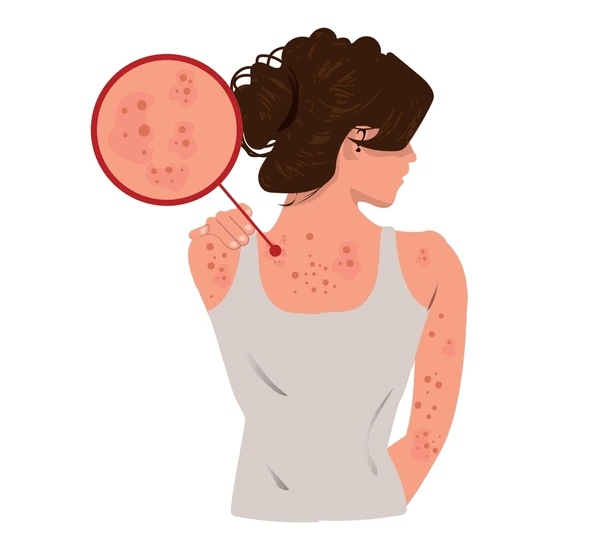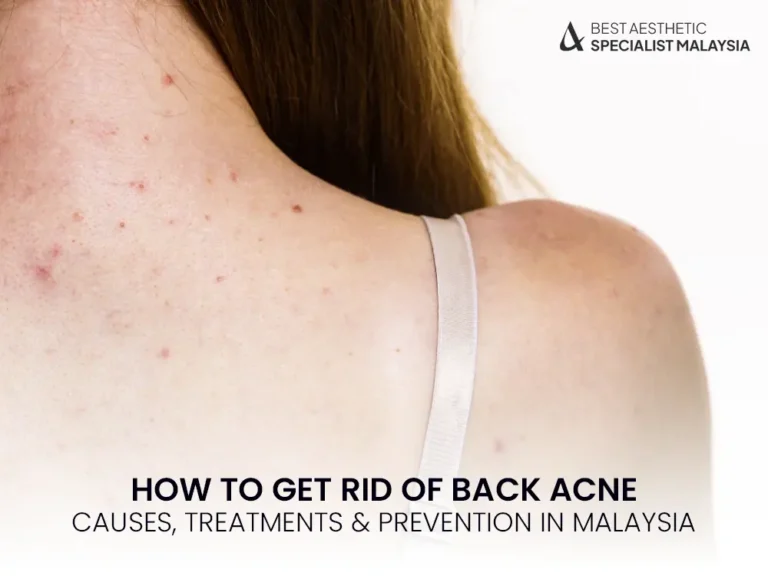Back acne treatment is essential for managing one of the most common skin concerns—often referred to as “bacne.” Affecting both men and women of all ages, back acne can be more stubborn than facial acne and typically requires targeted care. In this guide, we’ll cover the causes, symptoms, and proven back acne treatments available in Malaysia, with a focus on solutions offered by Best Aesthetic Specialist Centre—your trusted centre for advanced skincare.
What Is Back Acne (Bacne)?

Back acne, commonly referred to as bacne, is a skin condition that occurs when hair follicles on the back become clogged with oil, dead skin cells, and bacteria. It can range from mild blackheads and whiteheads to inflamed pustules or even painful cysts. Due to its location, back acne often goes unnoticed until it becomes severe.
Common Causes of Back Acne
Several internal and external factors can contribute to the development of bacne:
1. Excess Oil & Sweat
Back acne often occurs when excess sebum and sweat mix on the skin, clogging pores and creating a perfect environment for breakouts, especially after workouts.
2. Hormonal Imbalance
Fluctuating hormones—during puberty, menstruation, or stress—can increase oil production, leading to recurring back acne, particularly in teens and adult women.
3. Dead Skin Cell Buildup
When dead skin cells are not properly exfoliated, they can accumulate and block pores on the back, contributing to inflammation and acne formation.
4. Tight Clothing & Friction
Wearing tight or non-breathable clothing can trap sweat and cause friction on the skin, irritating pores and triggering a type of back acne called acne mechanica.
5. Unsuitable Body Products
Using comedogenic body washes, lotions, or conditioners can leave residue that clogs pores, especially on the upper back and shoulders, causing breakouts.
Symptoms and Types of Back Acne
Whiteheads and Blackheads
Whiteheads and blackheads are non-inflammatory forms of acne caused by clogged pores. Whiteheads are closed comedones, while blackheads are open comedones exposed to air, which darkens them.
Papules and Pustules
Papules are small red bumps that occur when clogged pores become inflamed. Pustules are similar but contain pus and appear as white or yellow-tipped bumps surrounded by redness.
Nodules and Acne Scars
Nodules are deep, painful lumps beneath the skin caused by severe inflammation. They can damage skin tissue and often lead to long-term acne scarring if left untreated.
How to Treat Back Acne Effectively
Treatment options vary based on severity and cause:
1. Topical Treatments (Salicylic Acid, Retinoids)
Benzoyl Peroxide: Kills acne-causing bacteria and reduces inflammation.
Salicylic Acid: Unclogs pores and reduces dead skin buildup.
Retinoids (Adapalene): Promotes cell turnover and prevents clogged follicles.
2. Oral Medications (Antibiotics, Isotretinoin)
Antibiotics: Reduces bacterial growth and inflammation.
Oral Retinoids (Isotretinoin): Used for severe or cystic acne.
Hormonal Therapy: Especially effective for women with hormonal imbalance.
3. Medical Procedures (Peels, Laser, Extractions)
Chemical Peels: Use of medical-grade acids to exfoliate and unclog pores.
Laser Therapy: Targets bacteria and reduces sebum production.
Comedone Extraction: Performed by a medical professional to remove deep blockages.
Prevention Tips for Bacne Breakouts
Consistent skin care and lifestyle habits play a major role in preventing bacne:
Shower After Sweating: Use a gentle body wash with salicylic acid.
Avoid Heavy Products: Choose non-comedogenic lotions and sunscreens.
Wear Breathable Clothing: Avoid tight fabrics that trap sweat.
Wash Bedsheets Regularly: Bacteria and oil from the skin can build up on bedding.
Exfoliate Weekly: Use a soft scrub or chemical exfoliant to prevent buildup.
When to See a Dermatologist
Consult a dermatologist if:
Over-the-counter treatments are ineffective after 6–8 weeks.
Acne is painful, cystic, or spreading rapidly.
There are signs of scarring or pigmentation.
You experience emotional distress or lowered confidence.
Frequently Asked Questions (FAQs)
1. What is the difference between facial acne and bacne?
While both share similar causes, bacne tends to be more severe due to thicker skin and larger sebaceous glands on the back.
2. Can diet affect back acne?
Yes. High-glycemic foods, dairy, and processed products may trigger inflammation and worsen acne in some individuals.
3. Is back acne contagious?
No, back acne is not contagious. It is caused by internal factors, bacteria, or pore blockages rather than infection spread.
4. Will back acne go away on its own?
Mild bacne may resolve naturally, but persistent or severe forms often require medical treatment for effective results.
5. Can stress cause back acne?
Yes. Stress can increase cortisol levels, which may boost oil production and trigger acne flare-ups.
Conclusion
Back acne (bacne) is a common skin concern caused by clogged pores, excess oil, sweat, and bacteria on the back. It may appear as blackheads, whiteheads, or deep cystic lesions. Treatments include topical agents like benzoyl peroxide and salicylic acid, oral medications, and medical procedures such as chemical peels and laser therapy. Prevention involves proper hygiene, breathable clothing, and exfoliation. If bacne persists or worsens, consulting a dermatologist is recommended for customized care and to prevent scarring.

